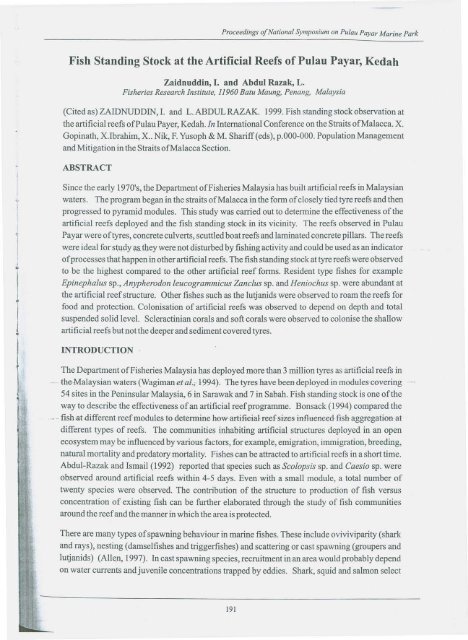Fish Standing Stock at the Artificial Reefs ofPulau ... - seafdec.org.my
Fish Standing Stock at the Artificial Reefs ofPulau ... - seafdec.org.my
Fish Standing Stock at the Artificial Reefs ofPulau ... - seafdec.org.my
- No tags were found...
Create successful ePaper yourself
Turn your PDF publications into a flip-book with our unique Google optimized e-Paper software.
<strong>Fish</strong> <strong>Standing</strong> <strong>Stock</strong> <strong>at</strong> <strong>the</strong> <strong>Artificial</strong> <strong>Reefs</strong> <strong>ofPulau</strong> Payar, KedahZaidnuddin, I. and Abdul Razak, L.<strong>Fish</strong>eries Research Institute, 11960 B<strong>at</strong>u Maung, Penang,Malaysia(Cited as) ZAIDNUDDIN, 1. and L. ABDULRAZAK.1999. <strong>Fish</strong> standing stock observ<strong>at</strong>ion <strong>at</strong><strong>the</strong> artificial reefs <strong>ofPulau</strong> Payer, Kedah. In Intern<strong>at</strong>ional Conference on <strong>the</strong> Straits ofMalacca. X.Gopin<strong>at</strong>h, X.Ibrahim, X.. Nik, F. Yusoph & M. Shariff (eds), p.OOO-OOO. Popul<strong>at</strong>ion Managementand Mitig<strong>at</strong>ion in <strong>the</strong> Straits ofMalacca Section.Since <strong>the</strong> early 1970's, <strong>the</strong> Department of <strong>Fish</strong>eries Malaysia has built artificial reefs in Malaysianw<strong>at</strong>ers. The program began in <strong>the</strong> straits ofMalacca in <strong>the</strong> form of closely tied tyre reefs and <strong>the</strong>nprogressed to pyramid modules. This study was carried out to determine <strong>the</strong> effectiveness of <strong>the</strong>artificial reefs deployed and <strong>the</strong> fish standing stock in its vicinity. The reefs observed in PulauPayar were oftyres, concrete culverts, scuttled bo<strong>at</strong> reefs and lamin<strong>at</strong>ed concrete pillars. The reefswere ideal for smdy a..s.<strong>the</strong>ywere not disturbed by fishing activity and could be used as an indic<strong>at</strong>orof processes th<strong>at</strong> happen in o<strong>the</strong>r artificial reefs. The fish standing stock <strong>at</strong> tyre reefs were observedto be <strong>the</strong> highest compared to <strong>the</strong> o<strong>the</strong>r artificial reef forms. Resident type fishes for exampleEpinephalus sp., Anypherodon leucogrammicus Zanclus sp. and Heniochus sp. were abundant <strong>at</strong><strong>the</strong> artificial reef structure. O<strong>the</strong>r fishes such as <strong>the</strong> lutjanids were observed to roam <strong>the</strong> reefs forfood and protection. Colonis<strong>at</strong>ion of artificial reefs was observed to depend on depth and totalsuspended solid level. Scleractinian corals and soft corals were observed to colonise <strong>the</strong> shallowartificial reefs but not <strong>the</strong> deeper and sediment covered tyres.The Department of <strong>Fish</strong>eries Malaysia has deployed more than 3 million tyres as artificial reefs in....thc-Malaysian w<strong>at</strong>ers (Wagimanet al.; ·1994). The tyres have been dep loyed in modules-covering-54 sites in <strong>the</strong> Peninsular Malaysia, 6 in Sarawak and 7 in Sabah. <strong>Fish</strong> standing stock is one of<strong>the</strong>way to describe <strong>the</strong> effectiveness of an artificial reef programme. Bonsack (1994) compared <strong>the</strong>.., - fish.<strong>at</strong> different reef modules to determine how-artifieial reef sizes-influeneed fish aggreg<strong>at</strong>ion ·<strong>at</strong>different types of reefs. The communities inhabiting artificial structures deployed in an open.ecosystem may be influenced by various factors, for example, emigr<strong>at</strong>ion, immigr<strong>at</strong>ion, breeding,n<strong>at</strong>ural mortality and pred<strong>at</strong>ory mortality.<strong>Fish</strong>es can be <strong>at</strong>tracted to artificial reefs in a short time.Abdul-Razak and Ismail (1992) reported th<strong>at</strong> species such as Scolopsis sp. and Caesio sp. wereobserved around artificial reefs within 4-5 days. Even with a small module, a total number oftwenty species were observed. The contribution of <strong>the</strong> structure to production of fish versusconcentr<strong>at</strong>ion of existing fish can be fur<strong>the</strong>r elabor<strong>at</strong>ed through <strong>the</strong> study of fish communitiesaround <strong>the</strong> reef and <strong>the</strong> manner in which <strong>the</strong> area is protected.There are many types of spawning behaviour in marine fishes. These include oviviviparity (sharkand rays), nesting (damselfishes and triggerfishes) and sc<strong>at</strong>tering or cast spawning (groupers andlutjanids)(Allen, 1997). In cast spawning species, recruitment in an area would probably dependon w<strong>at</strong>er currents and juvenile concentr<strong>at</strong>ions trapped by eddies.Shark, squid and salmon select
















